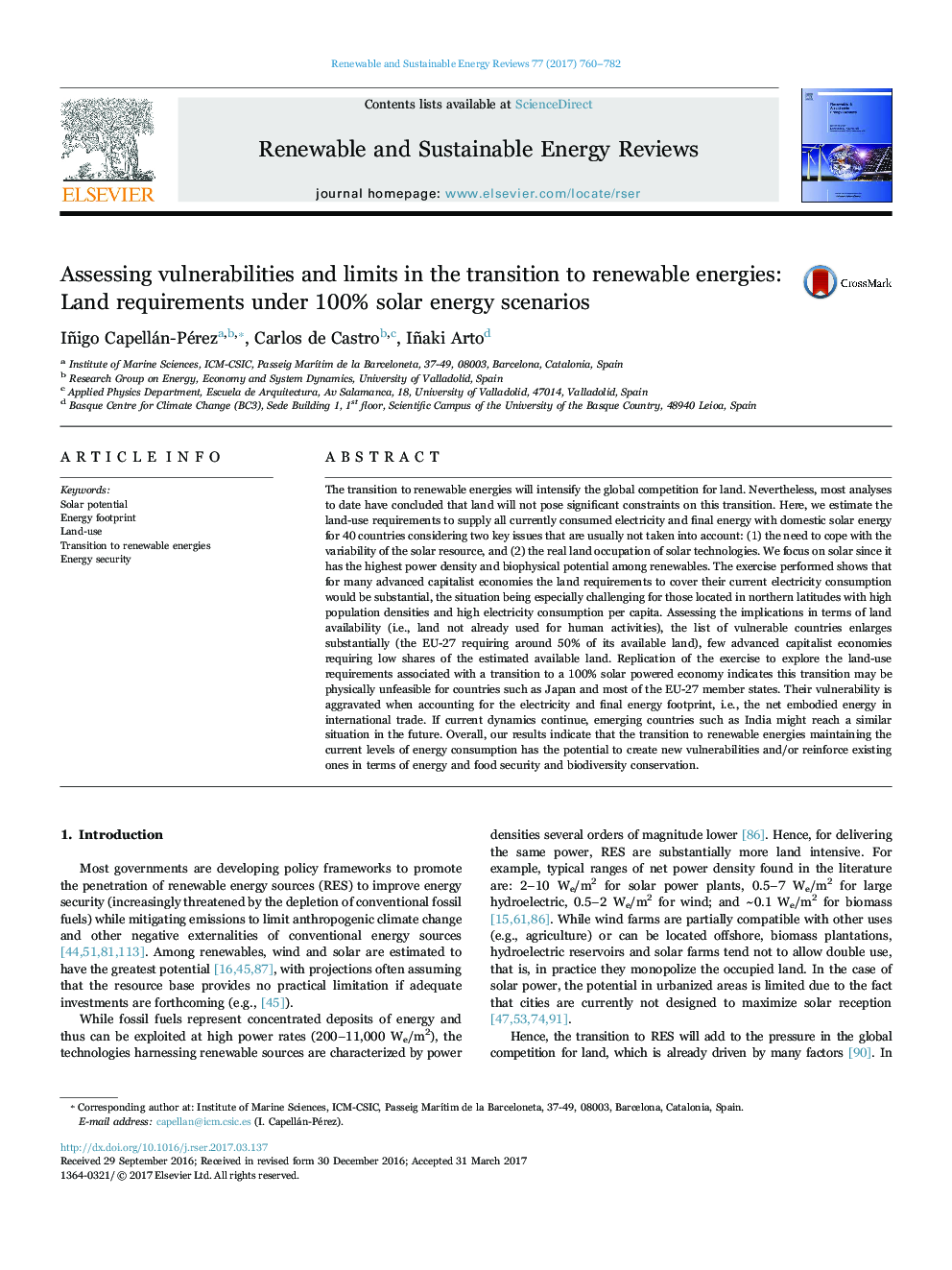| کد مقاله | کد نشریه | سال انتشار | مقاله انگلیسی | نسخه تمام متن |
|---|---|---|---|---|
| 5482976 | 1522309 | 2017 | 23 صفحه PDF | دانلود رایگان |
عنوان انگلیسی مقاله ISI
Assessing vulnerabilities and limits in the transition to renewable energies: Land requirements under 100% solar energy scenarios
ترجمه فارسی عنوان
ارزیابی آسیب پذیری ها و محدودیت های انتقال انرژی های تجدید پذیر: الزامات زمین تحت 100٪ سناریوهای انرژی خورشیدی
دانلود مقاله + سفارش ترجمه
دانلود مقاله ISI انگلیسی
رایگان برای ایرانیان
کلمات کلیدی
پتانسیل خورشیدی، پدیده انرژی، استفاده از زمین، انتقال به انرژی های تجدید پذیر، امنیت انرژی،
ترجمه چکیده
انتقال به انرژی های تجدید پذیر رقابت جهانی برای زمین را تشدید می کند. با این وجود، اغلب تحلیل ها تا به امروز نتیجه گرفته اند که زمین برای این انتقال محدودیت های مهمی نخواهد داشت. در اینجا، ما نیازهای استفاده از زمین را برای تامین تمام انرژی مصرف شده در حال حاضر و انرژی نهایی با انرژی خورشیدی خانگی برای 40 کشور برآورد می کنیم که با توجه به دو موضوع کلیدی که معمولا مورد توجه قرار نمی گیرند، عبارتند از: 1) نیاز به مقابله با تنوع خورشیدی منابع و (2) اشغال واقعی زمین از فن آوری های خورشیدی. ما روی خورشید تمرکز داریم زیرا دارای بیشترین تراکم انرژی و پتانسیل بیوفیزیکی در میان انرژی های تجدید پذیر است. تمرین انجام شده نشان می دهد که برای بسیاری از اقتصادهای پیشرفته سرمایه داری زمین های مورد نیاز برای پوشش مصرف برق فعلی قابل ملاحظه است؛ این وضعیت به ویژه برای افرادی که در عرض های شمال با تراکم جمعیت بالا و مصرف برق بالا در سرانه قرار دارند، چالش برانگیز است. ارزیابی مفاهیم مربوط به دسترسی به زمین (یعنی زمین که قبلا برای فعالیت های انسانی مورد استفاده قرار نمی گیرد)، لیست کشورهای آسیب پذیر به طور قابل ملاحظه ای افزایش می یابد (اتحادیه اروپا 27 که نیاز به حدود 50 درصد از زمین های موجود خود را دارد)، چندین اقتصاد پیشرفته سرمایه داری، زمین برآورد شده موجود است. تکرار این تمرین برای بررسی نیازهای استفاده از زمین در ارتباط با انتقال به یک اقتصاد 100٪ خورشیدی نشان می دهد که این انتقال ممکن است به لحاظ جسمی برای کشورهایی مانند ژاپن و اکثر کشورهای عضو اتحادیه اروپا 27 غیر قابل قبول باشد. آسیب پذیری آنها در هنگام حساب کردن انرژی الکتریکی و رد پای انرژی، یعنی انرژی خالص موجود در تجارت بین المللی، دشوارتر می شود. اگر دینامیک فعلی ادامه یابد، کشورهای در حال ظهور مانند هند ممکن است در آینده به وضعیت مشابهی برسند. به طور کلی نتایج ما نشان می دهد که گذار به انرژی های تجدید پذیر حفظ سطح فعلی مصرف انرژی بالقوه برای ایجاد آسیب پذیری های جدید و یا تقویت موجودات از نظر انرژی و امنیت غذایی و حفاظت از تنوع زیستی است.
موضوعات مرتبط
مهندسی و علوم پایه
مهندسی انرژی
انرژی های تجدید پذیر، توسعه پایدار و محیط زیست
چکیده انگلیسی
The transition to renewable energies will intensify the global competition for land. Nevertheless, most analyses to date have concluded that land will not pose significant constraints on this transition. Here, we estimate the land-use requirements to supply all currently consumed electricity and final energy with domestic solar energy for 40 countries considering two key issues that are usually not taken into account: (1) the need to cope with the variability of the solar resource, and (2) the real land occupation of solar technologies. We focus on solar since it has the highest power density and biophysical potential among renewables. The exercise performed shows that for many advanced capitalist economies the land requirements to cover their current electricity consumption would be substantial, the situation being especially challenging for those located in northern latitudes with high population densities and high electricity consumption per capita. Assessing the implications in terms of land availability (i.e., land not already used for human activities), the list of vulnerable countries enlarges substantially (the EU-27 requiring around 50% of its available land), few advanced capitalist economies requiring low shares of the estimated available land. Replication of the exercise to explore the land-use requirements associated with a transition to a 100% solar powered economy indicates this transition may be physically unfeasible for countries such as Japan and most of the EU-27 member states. Their vulnerability is aggravated when accounting for the electricity and final energy footprint, i.e., the net embodied energy in international trade. If current dynamics continue, emerging countries such as India might reach a similar situation in the future. Overall, our results indicate that the transition to renewable energies maintaining the current levels of energy consumption has the potential to create new vulnerabilities and/or reinforce existing ones in terms of energy and food security and biodiversity conservation.
ناشر
Database: Elsevier - ScienceDirect (ساینس دایرکت)
Journal: Renewable and Sustainable Energy Reviews - Volume 77, September 2017, Pages 760-782
Journal: Renewable and Sustainable Energy Reviews - Volume 77, September 2017, Pages 760-782
نویسندگان
Iñigo Capellán-Pérez, Carlos de Castro, Iñaki Arto,
